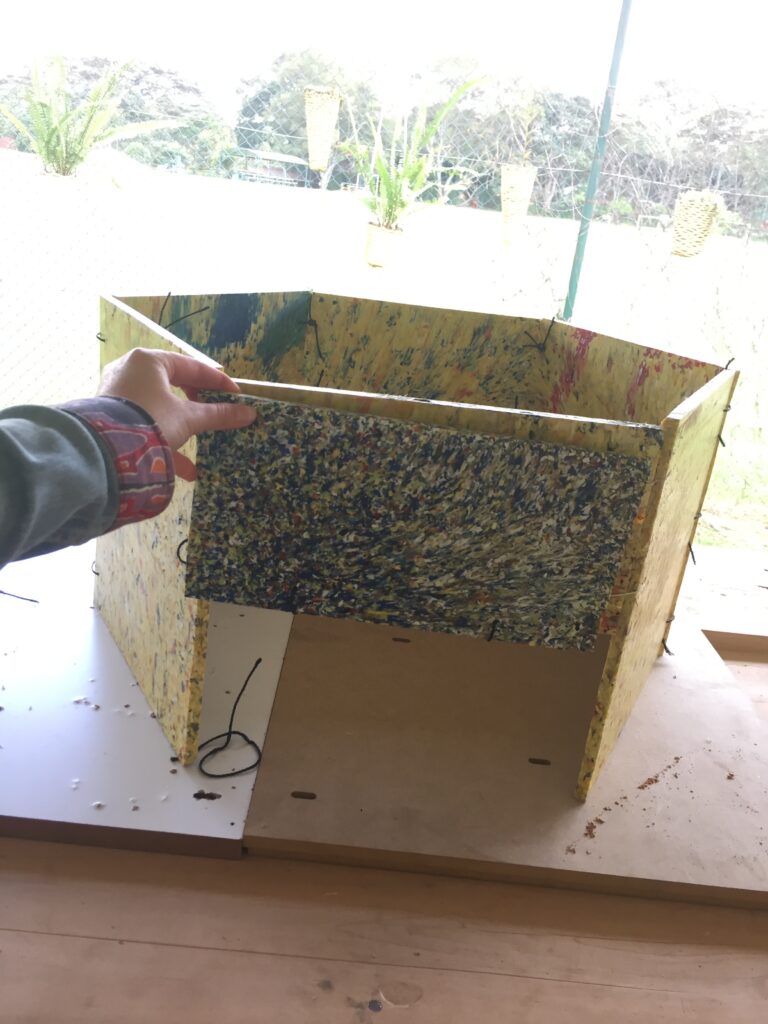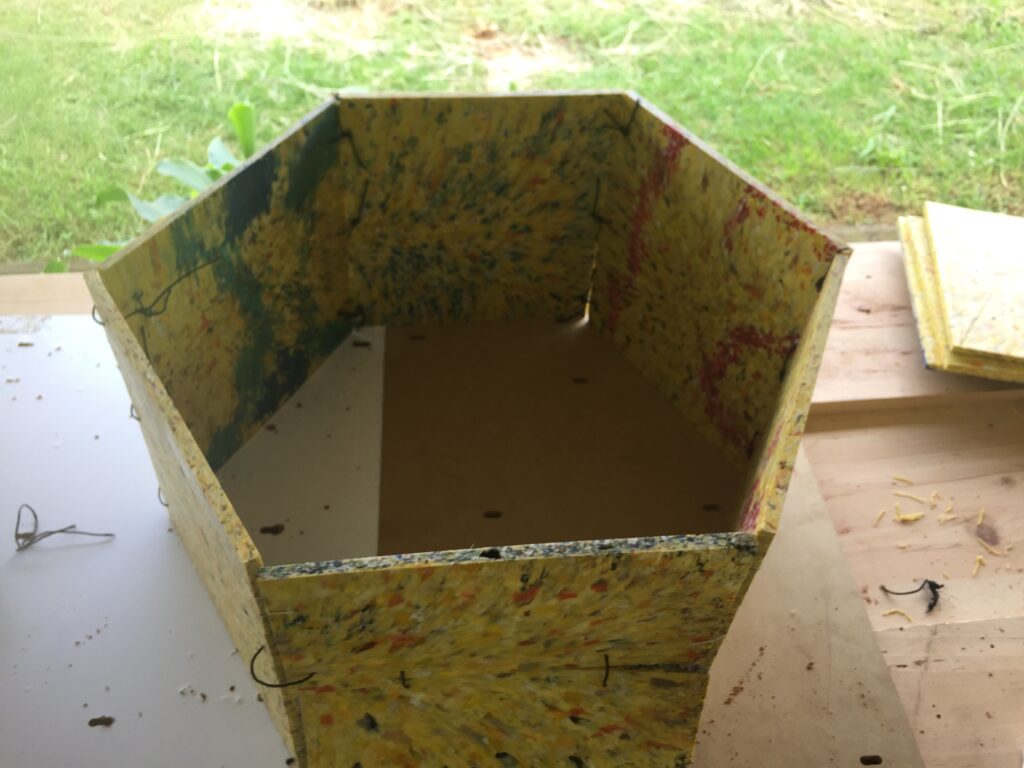Protecting Kenya’s Sea Turtles
Design Problem
Explain the problem you are trying to solve and how this leads to a design opportunity
I have always had a profound interest in sea turtles and marine conservation and have been fortunate to witness turtles hatching from their nests. That experience made a marked impression on me, especially when I learned how vulnerable they are and what a hugely negative impact humans are having on the survival of the species and their habitat. For this project, I wanted to focus on utilizing STEM to create solutions to challenges impacting Sea Turtles on the coast of Kenya.
Over the last few decades sea turtle populations have decreased rapidly worldwide. In total there are seven species of sea turtles, all of which are endangered and edging towards extinction. Out of these seven species, five have been reported in Kenyan waters; the green, the hawksbill, the loggerhead, the olive ridley and the leatherback turtles. Sea turtles are vital for the marine ecosystem and the maintenance of biodiversity in the ocean. As a long living and migratory species, they make use of all sorts of different habitats throughout their lives. If turtles are healthy and thriving, it’s a good indicator that the habitats they visit are too. Sea turtles face dangers throughout their lives from fisheries bycatch, coastal development, pollution and pathogens, direct take, and climate change. Additionally, there are numerous threats to eggs, hatchlings and young juvenile sea turtles, on land and in the sea. It is estimated that only 1 in 1,000 sea turtle hatchlings survives to adulthood, this startling statistic demonstrates how vulnerable this species is and that we need to act now.
Through independent research, as well as collaboration with the Diani Turtle Watch (DTW), a program of Local Ocean Conservation (LOC), I was able to identify specific challenges to sea turtle conservation in Kenya, and find some potential design opportunities for solutions using STEM. One of the main problems that turtles face in Diani is the establishment of sea walls from hotels and houses that protrude onto beaches. This causes a major problem for the turtles as they can no longer place their nests far enough away from the water’s edge. Therefore, the Diani Turtle Watch has begun to relocate many of the vulnerable nests to safer more protected areas. However, these relocated nests and hatchlings face additional local problems, such as predation of eggs and hatchlings by red fire ants, and disorientation of hatchlings when they try to make their way to the ocean at night due to floodlights.
Design Process
Summarize your design process. What did you learn. What challenges did you encounter and how did you overcome them. Looking towards the future – how could this project develop. Include photos and charts as appropriate.
When I visited Diani I was fortunate enough to meet members of the Diani Turtle Watch who were very supportive and helpful. I was able to visit the Marine Education Center, where I learnt more about sea turtles and the challenges they face from some very dedicated and passionate individuals. I also met the hosts of various sites along the beach where turtle nests are protected, and even helped the DTW team to relocate a turtle nest with 130 eggs! I was also fortunate enough to witness turtles hatching and begin their journey to the sea, which just increased my fascination and passion to help these amazing and vulnerable creatures. Many of the individuals I met provided me insight into the problems faced by sea turtles, and hatchlings in specific, as well as solutions that were trying out. One of the recurring comments was that red fire ants pose a serious threat to sea turtle eggs and hatchlings. Red fire ants enter nests through tunnels under ground. Often the turtle monitors do not notice until after the due date of hatching has passed and they dig to find out what is going on. As an example, in August 2020, five nests were found predated on by the ants, who attack the eggs and hatchlings for food. As every young juvenile of this endangered species is so precious, these are important losses. I originally aimed to find a way to disorient the fire ants by using some type of natural detergent which would disrupt their pheromone trails. Through research I found out that although there hasn’t been a specific solution, cinnamon and ash seem to work the best. I did also find out that wood (especially when rotting) can attract them.
Many of the nests that I visited were in fact surrounded by wooden poles / stakes placed there by the DTW monitors to mark the nests and protect them from dogs and people. Although these wooden stakes were treated with Neem tree oil, I knew that rotting wood could potentially attract the red fire ants. Therefore, I decided to try to protect and mark these nests in a different way. After identifying a problem, I was able to start brainstorming solutions and possible designs with the members of the DTW. I came up with various designs ideas for products made out recycled plastic rather than wood. These products, stakes and tags, would be reusable and environmentally friendly. As the marine environment is also polluted with plastic, using recycled plastic is also a way of using the pollution and raising awareness. By using recycled plastic, rather than wood, this should also aid in keeping red fire ants away from the nests. I decided to also tackle another problem, the disorientation of hatchlings when they try to make their way to the ocean at night due to floodlights. For this I worked with a host of the DTW relocated nests to adapt a nest protection box made of sisal, to a more portable and durable one made of recycled plastic.
Part 1: Recycled Plastic poles
This solution can help the eggs from being attacked by red fire ants. At the moment, the Diani Turtle Watch (DTW) is using wooden poles/sticks to surround the relocation sites and also to mark individual nests. However, wood attracts ants and they are susceptible to rotting. Therefore, a product that does not attract the red fire ants, does not rot, is durable and can be reused, and made from recycled materials would be a huge improvement. Based on observations from the sites I visited, two sizes of stakes are required. One taller for surrounding the whole relocation site, to which the turtle monitors tie nets to prevent people or dogs from entering, and a smaller size to surround and mark individual relocated nests.

When I took some samples of the poles to Diani, I was able to test them on site and evaluate the benefits and challenges. I realised that poles of lighter colours (like yellow for example), reacted better to the coastal climate as they didn’t absorb as much heat as darker colours (such as black). Using the design that I created (shown to the right), the recycled plastic poles were made a better size, as some needed to be slightly smaller. One idea that I had brainstormed with my teacher was to add a type of hook to the top of some of the poles, to allow the turtle tags to hang from them.
-
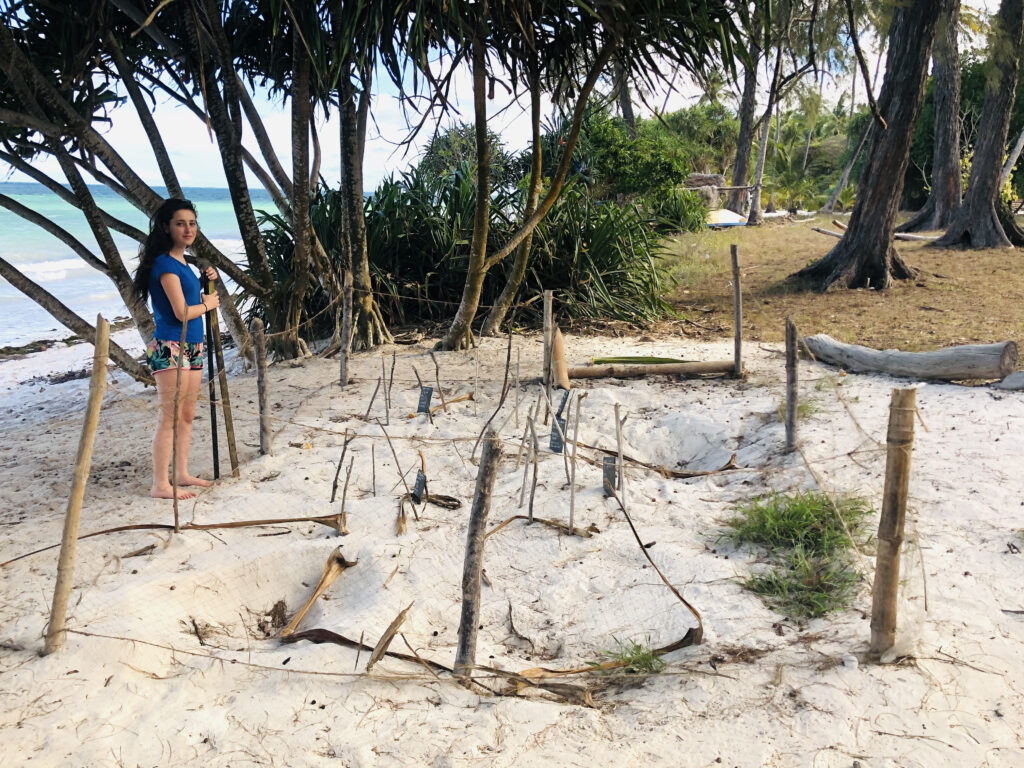
Wooden poles surrounding a group of turtle nests -
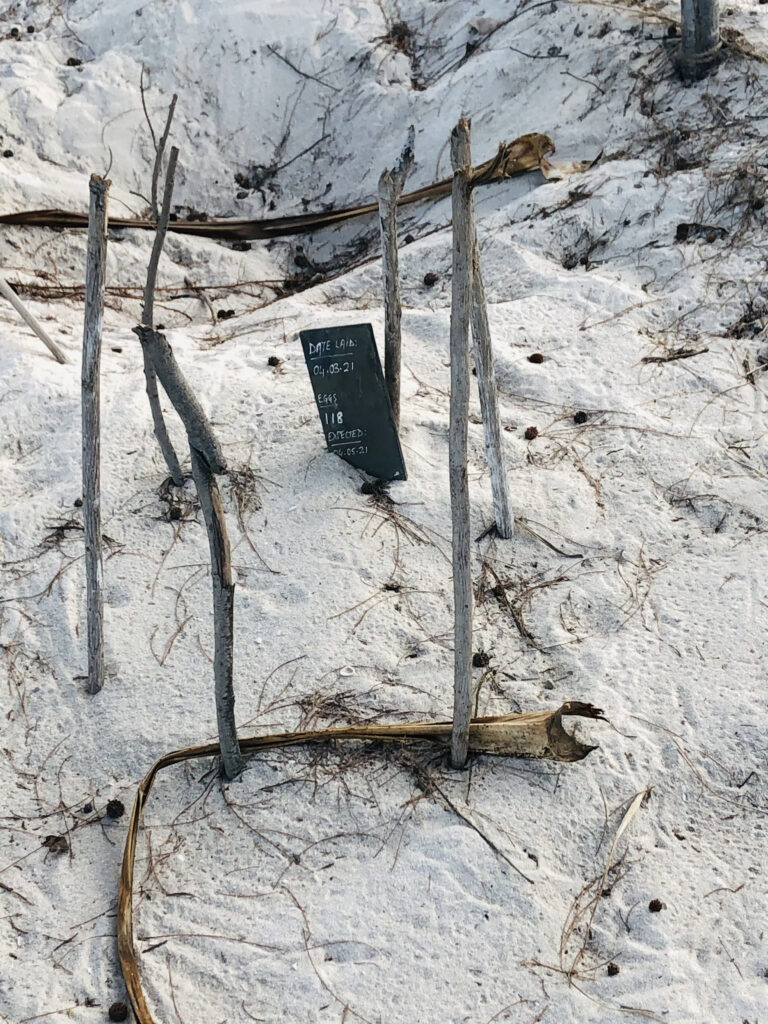
Wooden sticks surrounding a single turtle nest
Part 2: Recycled Plastic Turtle Nest Tags
These tags can be used in place of the current wooden boards to label each nest with data. The boards are used to write the date the eggs were laid, and expected due date for hatching, as well as number of eggs relocated. These tags will mean less wood on the site, and be more durable to the elements of the coast. They are made in the shape of sea turtles.
These were tags that had been previously designed and created by the Plastiki Rafiki team. As they served the same purpose as the idea that I had in mind, they were a good addition to the products that could be developed and sent to Diani. One challenge that we were trying to overcome, was how to display these tags so that they would be visible but secure in order to not run the chance of them being taken. We thought it would work well to attach them to the top of some of the plastic sea turtle poles, as this would meet the criteria previously stated. I also believe that having the tags and stakes connected would help the DTW team to transport and store all the products in a more organised way.
I took samples of recycled plastic stakes and tags to Diani and showed them to all the key stakeholders. The Director of Diani Turtle Watch, as well as two of the hosts of the relocation sites and various turtle monitors. All were extremely enthusiastic about the materials and ideas, they contributed with additional inputs. I tested the products for a week in the environment, leaving the samples out in the sand, during rainy and hot days. They did not modify in shape or size. Therefore, I am confident these products will be durable and long lasting, as well as serve the needs of the Diani Turtle Watch.
Part 3: Recycled Plastic Nest Protector
The first idea that I came up with were nest protector baskets to help protect the turtle hatchlings when they are born. The purpose of this product is to keep the hatchlings safe in one area, particularly if they hatch when turtle monitors are not there to keep an eye on them. This is a threat that does occur when the monitors are not present, particularly at night when the hatchlings may be disoriented by neighbouring floodlights on the beach. These nest protectors are currently being used in the form of a sisal basket at one of the five relocation sites in Diani. However, the host explained that while they work well and serve their purpose, they are not durable, and the materials may also attract red fire ants if they rot. Therefore, we designed a modular nest protector that can be durable and also come apart for easier storage and transportation.
-
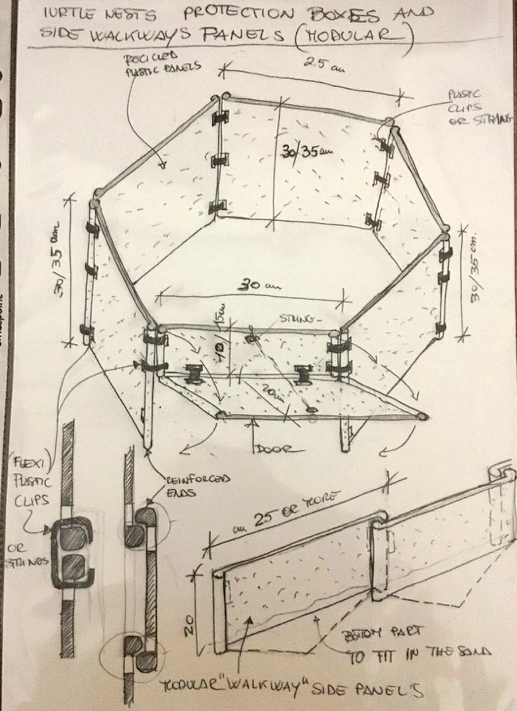
Sketch / Design of a Turtle Nest Protector
I started the design process by creating a sketch of the nest protector with help from a member of DTW who already had some measurements in mind. To the left is the sketch / design of the nest protector, which I had to simplify a bit in order to make it easier to achieve as we did not have the clips. This design is made out of six panels, one of which is split in half, with a top section used as a door that can be propped up to let the turtles go out in the direction of the sea. I simplified it by not including the rounded ends of each panel, as these weren’t necessary because of the recycled plastic material’s strength and durability.
After transferring this design to Illustrator, I used the laser cutter in the STEM lab to made a prototype out of cardboard. This prototype was meant to tackle issues and refine the design before cutting the product out of plastic.
The prototype (shown below), was a good size and it was foldable, which is helpful to allow the monitors to transport them to different sites and store them when not in use. However there were some issues that I needed to resolve before beginning the final nest protector. The door flap was not supported enough when open, and as the panels made out of plastic are quite heavy, I decided to add a few more attachment holes to work as ‘hinges’.
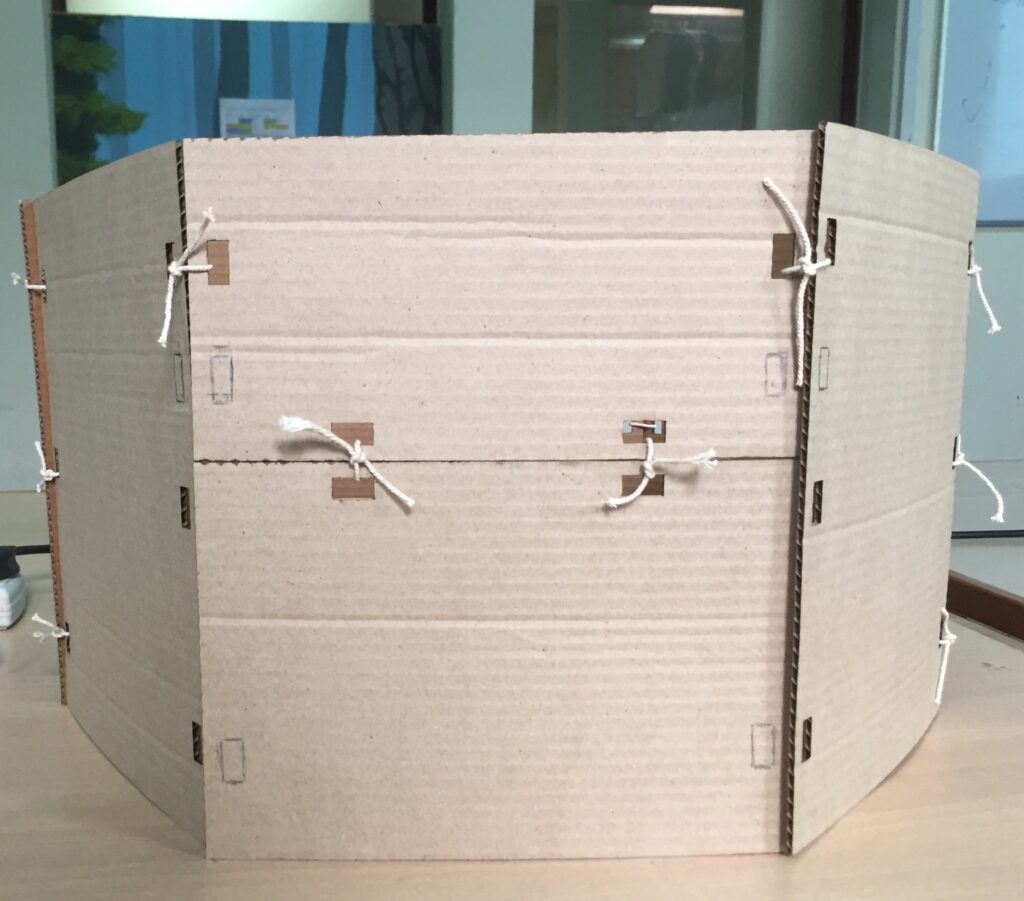
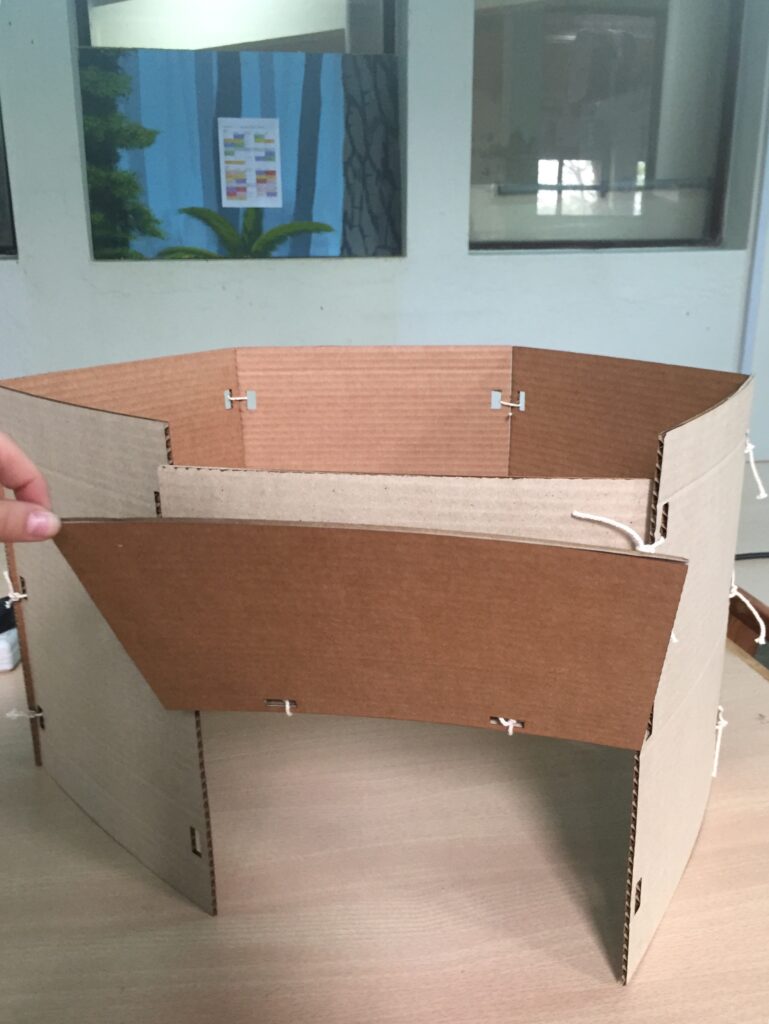
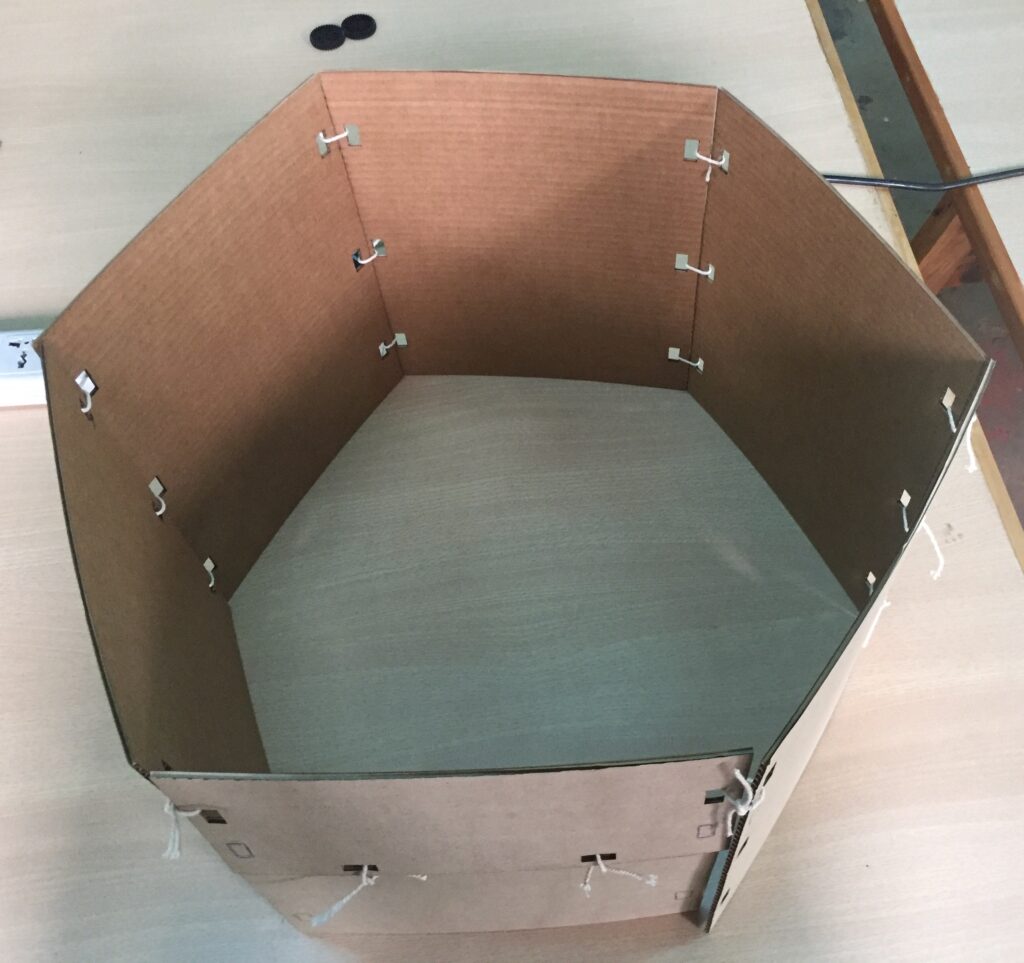
The prototype was helpful as based on this I was able to refine and improve my design and move onto the second phase: the creation of the actual product. In order to make the products, waste plastic had to be sorted into categories based on type of material, then washed, shredded and melted into panels. Yellow was an ideal colour to use for the outside of the panels, as it doesn’t absorb as much heat as darker colours, which is important for a location with high temperatures. I had to adjust the size of the panels as they were quite large and heavy, which made them hard to carry. When they were the right size, I began assembling the pieces, using a plastic string to join them. I faced a few difficulties at this stage, however, as the string was quite slippery and therefore did not stay well knotted. When I tried to tie the knots tighter, the panels did not fold down flat. This was a problem as the beauty of the design is that it should be easily foldable and portable. To resolve this I needed to find an alternative to the string for tying the panels together. One idea was to use twine, however this would not solve the problem of the box not being collapsable. I will be making a second similar nest protector, however this time I aim to find a different way of connecting the panels, for example by making the holes bigger and utilising a type of recycled plastic ring instead of string.
In the future, I will definitely continue to improve these designs. I also have ideas for new ones to aid in sea turtle and marine conservation. My products still need more testing, designing, prototyping and sharing before they are problem free. I will also need to send my products to Diani so that the Diani Turtle Watch can test them on the field and give me feedback and thus continue to improve them. Another product that the DTW have asked me to try and help them make are side panels to guide the hatchlings to the sea from the nest protectors. At the moment, they have makeshift panels out of wooden planks, however they would be much more sturdy, durable, reusable and transportable if they were made from recycled plastic.
Link to Process Journal and Final Reflection Video
Please create a link to your process journal (website, Google Doc, etc…)
Link to my Interview Information Document
Final Reflection Video:

